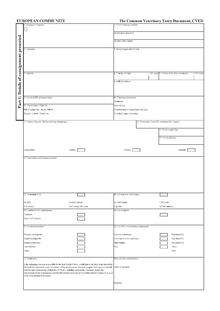Common Veterinary Entry Document
For other animal passports, see Animal passport.

Example of a blank CVED.
The Common Veterinary Entry Document (CVED) is the official document used in all member states of the European Union (EU) to pre-notify the arrival of each consignment[1] of live animals (pets not included), live animal products and products of animal origin intended for import to or transit through the EU from third countries.[2]
- The first part of the CVED contains relevant information about the consignment and is intended for the notifying part to report to the competent veterinary authority[3] in the Border Inspection Post[4] (commonly abbreviated as BIP)
- The second part of the CVED shows the results of the conducted checks[5] and is used by the competent authority at the BIP to communicate to the notifying part the decision regarding the consignment.
A CVED can be submitted on paper or by electronic means using the application TRACES[6] (abbreviation for TRAde Control and Expert System)
References
- ↑ 2007/275/EC: Commission Decision of 17 April 2007 concerning lists of animals and products to be subject to controls at border inspection posts under Council Directives 91/496/EEC and 97/78/EC
- ↑ Council Directive 97/78/EC of 18 December 1997 laying down the principles governing the organisation of veterinary checks on products entering the Community from third countries
- ↑ Regulation (EC) No 882/2004 of the European Parliament and of the Council of 29 April 2004 on official controls performed to ensure the verification of compliance with feed and food law, animal health and animal welfare rules
- ↑ List of approved veterinary border inspection posts of the EU
- ↑ Commission Regulation (EC) No 136/2004 of 22 January 2004 laying down procedures for veterinary checks at Community border inspection posts on products imported from third countries
- ↑ Trade Control and Expert System
External links
This article is issued from Wikipedia - version of the 7/8/2016. The text is available under the Creative Commons Attribution/Share Alike but additional terms may apply for the media files.